
Dunedin is the second-largest city in the South Island of New Zealand, and the principal city of the Otago region. Its name comes from Dùn Èideann, the Scottish Gaelic name for Edinburgh, the capital of Scotland. The city has a rich Māori, Scottish, and Chinese heritage.
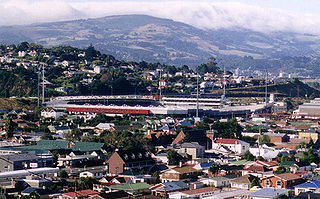
Carisbrook was a major sporting venue in Dunedin, New Zealand. The city's main domestic and international rugby union venue, it was also used for other sports such as cricket, football, rugby league and motocross. In 1922, Carisbrook hosted the first international football match between Australia and New Zealand. The hosts won 3–1.
Dunedin is a city of 136,000 people in the South Island of New Zealand. The principal suburbs of Dunedin are as follows. Inner and outer suburbs are ordered by location, clockwise from the city centre, starting due north:

The Water of Leith, is a small river in the South Island of New Zealand.

Dunedin railway station is a prominent landmark and tourist site in Dunedin, a city in the South Island of New Zealand. It is speculated by locals to be the most photographed building in the country, as well as the second most photographed in the southern hemisphere, after the Sydney Opera House.
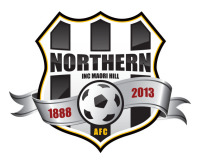
Northern FC are based in the Northern area of the city of Dunedin, within the Southern Football Federation region of the New Zealand Football structure.

Otago Polytechnic is a public New Zealand tertiary education institute, centred in Dunedin with additional campuses in Cromwell and Auckland. Otago Polytechnic provides career-focused education and training, offering a range of New Zealand accredited postgraduate qualifications, degrees, diplomas and certificates at levels 2–10. In November 2022, it became a business unit of the national mega polytechnic Te Pūkenga, ending its existence as an independent entity.

Logan Park High School is a high school founded in 1974 in Dunedin, New Zealand. It has a roll of 791 students as of August 2024 with a teaching staff of about 50, with some 18 further auxiliary and administrative staff.
The New Zealand and South Seas International Exhibition was a world's fair held in Dunedin, New Zealand, from 17 November 1925 until 1 May 1926, which celebrated that country and the South Seas. It was the third such exhibition held in Dunedin, with earlier exhibitions in 1865 and 1889. The exhibition had over 3 million visitors. It had added a new 'Special Exhibits' section focusing on art and craftwork made by women, a breakthrough that lifted the profile of women's art and craftwork.

The villages and then city that lay at the head of Otago Harbour never existed in isolation, but have always been a staging ground between inland Otago and the wider world. While Dunedin's current official city limits extend north to Waikouaiti, inland to Middlemarch and south to the Taieri River mouth, this articles focus is the history of the Dunedin urban area, only mentioning Mosgiel, the Otago Peninsula, Port Chalmers and inland Otago for context.

The University of Otago Oval is a sports ground located at Logan Park, Dunedin, New Zealand, and owned by the Dunedin City Council. It was opened by Sir Louis Barnett on 5 April 1930. The ground was originally owned by the University of Otago, but ownership was transferred to the city council when a redevelopment was completed in the early 2000s.
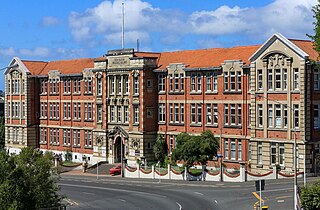
King Edward Technical College is a former school and technical college in Dunedin, New Zealand. The college was established in 1889 as the Dunedin Technical School when the Caledonian Society instigated night education classes.

The City of Dunedin Pipe Band is a competitive pipe band, based in Dunedin, New Zealand. The band is led by Pipe Major Murray Tannock and Drum Sergeant Sam Coutts. The band wears the Gordon Tartan. The band regularly performs at all home games for the Otago Highlanders Super Rugby franchise at Forsyth Barr Stadium and graduation parades for the University of Otago and Otago Polytechnic.
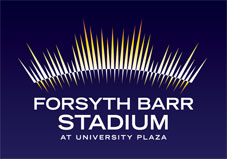
Forsyth Barr Stadium is a multi-purpose stadium in Dunedin, New Zealand. At various stages of development it was also known as Dunedin Stadium or Awatea Street Stadium, or its non-commercial official name during the 2011 Rugby World Cup and 2015 FIFA U-20 World Cup, Otago Stadium. The fully covered stadium is also known colloquially as 'The Glasshouse' due to its resemblance to a horticultural hothouse.
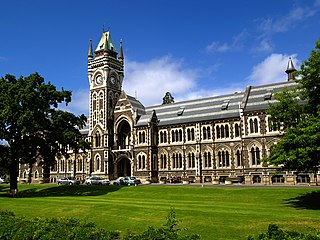
Dunedin North, also known as North Dunedin, is a major inner suburb of the New Zealand city of Dunedin, located 1.5 kilometres (0.93 mi) northeast of the city centre. It contains many of the city's major institutions, including the city's university, polytechnic, main hospital, and largest museum. Dunedin North's 2001 population was 7,047, including the university area.

Ravensbourne is a suburb of the New Zealand city of Dunedin. It is located on Otago Harbour on the steep southeastern slopes of Signal Hill. It lies on the harbour's northern shore, 4.5 kilometres (2.8 mi) east-northeast of the city centre.

The Caledonian Ground, often simply known as "The Caley", is a major sports venue in the New Zealand city of Dunedin. It is primarily used for football (soccer) and athletics, and has a capacity of 7,500.
State Highway 88 (SH 88) is a New Zealand State Highway connecting the city centre of Dunedin with Port Chalmers, which is the location of Dunedin's main port facilities and home of one of New Zealand's major container terminals. It is roughly 12 km long.

The Cenotaph in the southern New Zealand city of Dunedin stands in the centre of Queens Gardens, close to the city centre. It is the city's main war memorial.
Te Aka Ōtākou is a cycleway and shared pathway for walking and cycling in Dunedin, New Zealand, which follows the shoreline of the Otago Harbour. It also known as the Otago Harbour Cycleway, and has previously been known by various names, including The Harbour Loop, and by the names of various sections.




















